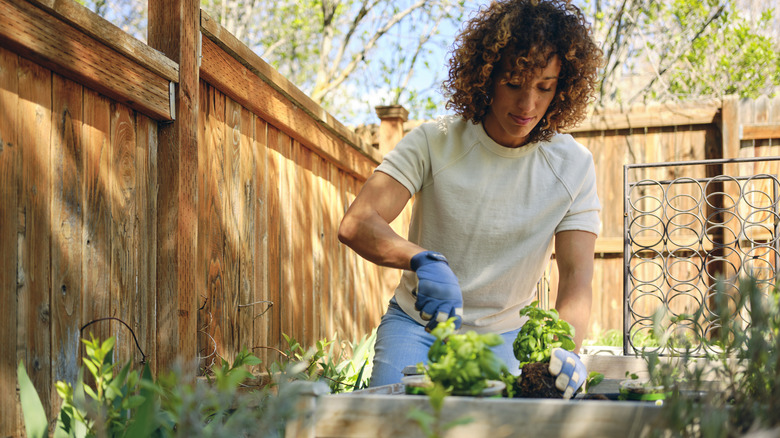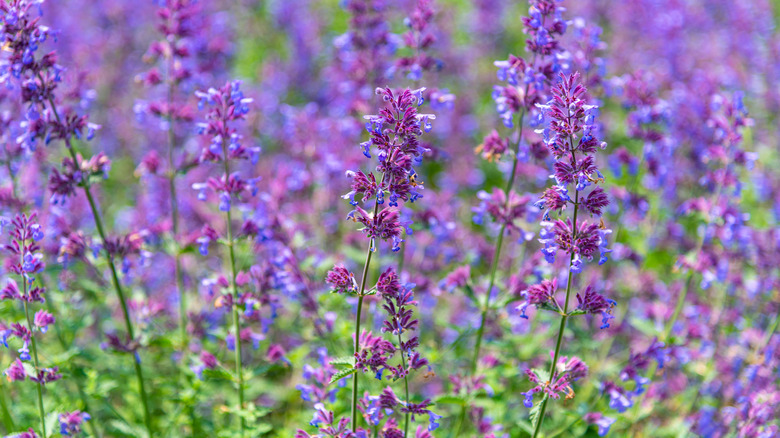The Fast-Growing Herb That Only Needs A Little Bit Of Water To Propagate
Beloved by felines and surprisingly useful to humans, catnip (Nepeta cataria) is a fast-growing herb that is easy to propagate from simple cuttings, whether you grew your plant from seed or purchased one at the store.
Catnip is a perennial herb from the mint family with a long history of use as a home remedy for everything from fevers to the flu. Today, it's mostly known for its calming effect on humans and its effectiveness as a natural bug repellent. For cats, however, this plant triggers a playful, euphoric response. Science shows that when cats smell the plant's fragrant essential oils, it activates their opioid systems. Other studies have shown the scent mimics sex hormones in cats, promoting happiness and relaxation.
Whether you're looking to grow your own for a nighttime tea or to provide enrichment for your cats, propagating this fast-growing herb only requires a bit of water. You'll start by removing the lower leaves from several cuttings before placing them in a cup of water. Roots will develop in a matter of days when you change the water regularly. From there, you can plant each cutting.
The best method for propagating catnip
If you've only used catnip for your pets, chances are you're only familiar with the dried, leafy material packed and sold in stores. In reality, catnip grows and spreads in garden beds quickly, producing white and purple flowers from late spring through fall and reaching up to 3 feet in height. Its delicate leaves are either heart-shaped or oval with pointed tips and jagged edges. Bees and other pollinators love this plant while mosquitoes tend to avoid it, making it a great natural repellent for your yard.
In order to successfully grow a catnip plant, simply remove one of its square stalks by snipping with sharp scissors below a node. Then, remove the lower leaves of the plant, leaving a few at the top. Roots will grow in less than a week when you place the stems upright in water — just be sure to change the water regularly. Once the roots have grown to an inch or two, you can plant each stem in its own soil, in about two to three weeks.
Once you've planted each cutting, be sure to set the plants in full sun, watering only occasionally as these plants are hardy even in droughts. Sandy soil is best, but don't bother fertilizing as this can negatively impact the plant's scent. Catnip does well in USDA Hardiness Zones 3 through 9.
Planting your catnip from seed? Be sure to stratify each seed by scratching the surface so roots have an easier time sprouting. Next, mimic winter temps by freezing your seeds. Some gardeners recommend doing this for several weeks, but they should stay at this temperature at least overnight. Then, soak your seeds in water before planting in soil. If planting outdoors, it's best to do so in spring or fall.
Harvesting catnip and allowing it to reseed
Because catnip grows so quickly, it's always ready for harvest. You can pluck the leaves from the plant anytime and give them to your cat for a little stimulation. It's also common to dry the leaves before crushing them for teas. There are also other varieties of catnip, including lemon catnip (Nepeta cataria spp, citriodora) which has a citrus scent, that can give you the opportunity to experiment with different flavors.
If you're looking to grow more plants, you can also remove the flowers to plant again or allow them to fall to the ground and reseed. Left to its own devices, catnip will return year after year, spreading in your garden.
Even if you don't plan to harvest and use your catnip, it's doing double duty in your yard. Catnip is the fast-growing herb that might keep your yard tick-free, so there are plenty of reasons why you should grow catnip even if you don't have cats.


